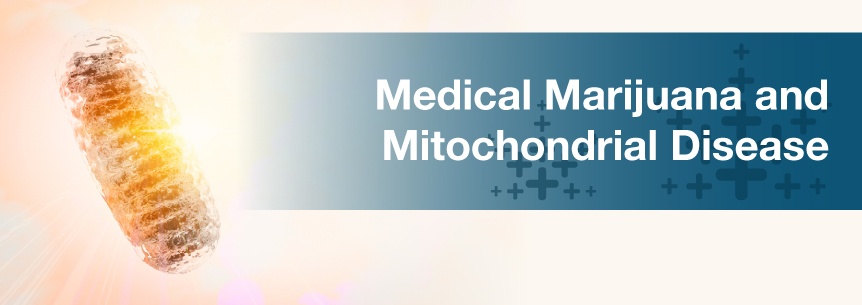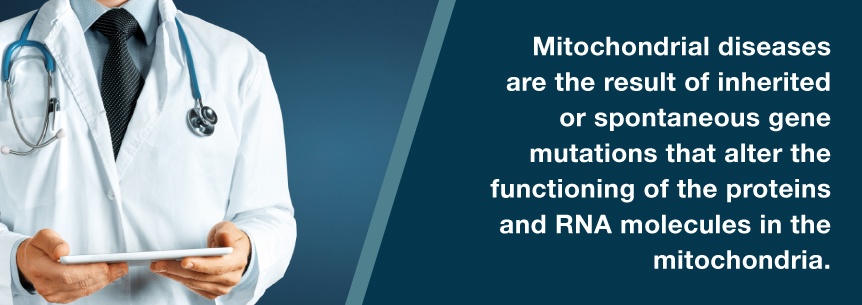
Mitochondrial disease is a complicated group of ailments that affects each patient differently. Some mitochondrial disorders are severe or even fatal, while others have a much smaller impact on daily life. For many people suffering from a mitochondrial disease, their symptoms may change dramatically from day to day, making it challenging to establish a healthy lifestyle. Mitochondrial disease is also connected to the development of many other more debilitating diseases. Therapy and other treatments for mitochondrial diseases have varied success and can sometimes cause a patient’s condition to decline.
For those navigating the confusing ups and downs of mitochondrial disease, medical marijuana can help. Cannabis offers relief from many symptoms of mitochondrial diseases, as well as conditions that can result from a mitochondrial disorder. If you are suffering from a mitochondrial disease, medical marijuana may be the natural treatment you have been looking for.
Mitochondrial diseases are the result of the mitochondria in a person’s cells not functioning properly. Mitochondria are organelles that exist in the cells of all multicellular organisms. In humans, mitochondria are present in every type of cell except for red blood cells. Often nicknamed “the powerhouse of the cell,” mitochondria perform many essential functions that keep the body working in a healthy way.
The primary function of mitochondria is to convert high-energy molecules, such as amino acids and sugars, into energy cells can use. This energy, called adenosine triphosphate or ATP, acts as fuel for the cell that allows it to function correctly. Mitochondria also play a part in many other processes, including cholesterol metabolism, regulating the rate of hemoglobin production, detoxifying ammonia in the liver and synthesizing estrogen and testosterone. Overall, mitochondria perform a complex and integral role in maintaining homeostasis in the body.
When a person’s mitochondria are not functioning correctly, cells in the body can only produce a limited amount of energy and are unable to make RNA and DNA that is necessary for their growth and function. Cells affected by mitochondrial failure become injured or die. That can lead to entire systems in the body failing, such as the respiratory, endocrine or cardiovascular system. Mitochondrial diseases that are most severe are typically those that affect the brain, muscles or nerve tissue, as these types of cells require more energy and rely more heavily on mitochondrial activity for proper functioning. Depending on which cells mitochondrial failure affects, mitochondrial disease can look very different from patient to patient.
Mitochondrial diseases are the result of inherited or spontaneous gene mutations that alter the functioning of the proteins and RNA molecules in the mitochondria. These mutations can occur in the nDNA — the DNA in the cell’s nucleus — or the mtDNA — the DNA in the mitochondria. Mitochondrial diseases are most often genetic, and are more prevalent among children than adults. With inherited DNA mutations, other family members or siblings often have mitochondrial disease as well. The onset of inherited mitochondrial disease typically occurs before age 20, but can sometimes happen later in life. Less commonly, mitochondrial diseases are due to external causes, including infections, environmental toxins, drug use, some medicines and unhealthy lifestyles. In the U.S., about one in 4,000 people has a mitochondrial disease.

Because of the diverse role of the mitochondria in the cells and the many potential patterns of mitochondrial failure, there are hundreds of different mitochondrial diseases. Each of these disorders presents a different set of symptoms and can look different from patient to patient. For some patients, mitochondrial failure occurs only in specific tissues, organs or types of cells, but in most cases, multiple body systems are affected.
Medical professionals don’t entirely understand the relationship between the pattern of mutations and the resulting symptoms of mitochondrial. In some cases, two patients whose mtDNA have the same mutations show different signs. Conversely, two patients with different mitochondrial mutations may exhibit the same pattern of symptoms. For this reason, mitochondrial disease can be challenging to diagnose.
While each case of mitochondrial disease is different, here are a few common symptoms of mitochondrial failure:
Mitochondrial disease also links to a wide range of other diseases. Mitochondria play a role in proper neuron functioning, as neurons require a high amount of energy to function properly. Mitochondrial failure in neurons can lead to neurodegenerative disorders, such as Alzheimer’s and other dementias. Mitochondrial dysfunction is also evident in many other ailments, including:
While it is not definite mitochondrial dysfunction is the cause of other disorders, mitochondrial dysfunction or failure is evident in these diseases.
There is currently no cure for mitochondrial diseases, so the treatment of mitochondrial diseases instead aims to alleviate symptoms and slow or halt the progression of the disease. For some patients, effective treatments already exist for the symptoms or effects of their mitochondrial disorder. For example, those who exhibit seizures as a symptom of their mitochondrial disease can take seizure medicine. Other patients suffering from a mitochondrial disease must often employ a variety of treatments tailored to their particular set of symptoms.
Below are a few current treatment methods to reduce the symptoms and slow the progression of mitochondrial diseases.
Because mitochondrial diseases can vary so widely, patients should consult a physician before beginning any treatments, including altering their diet.
The effectiveness of current treatments for mitochondrial disease varies from patient to patient and depends on the type of affected cells and the severity of their disease. In general, those with milder mitochondrial disorders will experience more success with treatment than those with severe mitochondrial disorders. Some patients can experience symptom relief and slowed progression of mitochondrial disease with treatment programs tailored expertly to their specific set of symptoms. For other patients, however, personal treatment plans that should be effective do not result in benefits or improvement.
The success of treatment for mitochondrial disease also happens on a case-by-case basis. Some patients will see immediate benefits from therapy, while others may not experience benefits until several months into treatment programs. For others, treatment for mitochondrial disease may effectively slow the progression of the disease on a cellular level without displaying any noticeable relief of symptoms for the patient.
For some patients, treatment for mitochondrial disease will not be effective at all or may cause their condition to decline. Treatment for mitochondrial disease also cannot reverse any damage that has already happened to cells. So, patients who have already sustained neurological damage or other debilitating effects may not find treatment beneficial except to stabilize their current condition.
Medical cannabis for mitochondrial disease offers excellent potential as a treatment because of the antioxidant properties of some cannabinoids and the ability of cannabinoids to regulate mitochondrial activity. Cannabinoids can help balance oxidative stress that is a natural byproduct of mitochondrial function. When mitochondria convert nutrients to energy, it necessarily produces some oxidative stress. If oxidative stress is too high, the body may release damaging free radicals that interact with cell membranes, proteins, DNA and other organelles. Antioxidants protect against damage from oxidative stress by neutralizing free radicals. Because the cannabinoids THC and CBD both have antioxidant properties, medicinal weed may help to reduce the damage from oxidative stress caused by dysfunctional mitochondria.

Cannabinoids in marijuana can also help maintain the proper balance of oxidative stress created by mitochondrial activity. In moderate levels, oxidative stress serves as a helpful indicator to cells that signals for damaged mitochondria and other dysfunctional cell parts to get replaced with new ones. However, if oxidative stress levels become too high, it can cause damage in the cell or cause the cell to destroy itself in a process called apoptosis. Autophagy and apoptosis work together to maintain homeostasis in the cells. If this natural regeneration process is not working correctly, damaged cells and free radicals can accumulate in the body. This imbalance can lead to the development of a range of diseases and an increased rate of neurodegeneration.
Medical marijuana for mitochondrial disease may help maintain the balance of autophagy and apoptosis in cells in varied ways. THC in smaller doses can increase mitochondrial activity by interacting with the mitochondrial membrane to promote the creation of ATP. This process also aids in cell regeneration by triggering autophagy that repairs damaged cell parts. Higher doses of THC can decrease the activity of mitochondria by binding to CB1 receptors to decrease mitochondrial activity and thus decrease oxidative stress. Cannabinoids may also suppress neurodegeneration to slow the aging process and slow the onset of dementia.
A variety of clinical studies have been performed to examine the effects of cannabinoids on mitochondrial activity. Research suggests that cannabinoids interact with mitochondria in a way that improves and regulates their function. These studies provide support for medical marijuana as a valid treatment option for mitochondrial diseases.
A 2012 study published in Philosophical Transactions of the Royal Society B: Biological Sciences concluded that the endocannabinoid system has a multiphasic interaction with mitochondria and modulates mitochondrial function through multiple pathways. Endocannabinoids in the body can interact with mitochondria to both restore and destroy cells, depending on oxidative stress levels. That suggests the potential for THC and other cannabinoids to regulate mitochondrial function. A 2007 study published in Biochemical and Biophysical Research Communications, demonstrated similar effects of THC and two other cannabinoids to alter mitochondrial function.
A 2014 study in the American Journal of Physiology demonstrated stimulation of the endocannabinoid system could improve cellular respiration by interacting with mitochondria, which suggests the benefit of treatments for mitochondrial diseases that target the endocannabinoid system.
A 2012 study on aging showed cannabinoid interaction with mitochondria could suppress neuroinflammatory processes that contribute to aging and slow neurodegeneration. It improves motor and cognitive impairment that result from neurodegenerative diseases, as well as slowing natural cognitive decline. This study also echoed the consensus that cannabinoids can regulate mitochondrial activity to preserve homeostasis in cells.
In addition to cannabis’ potential to regulate mitochondrial activity in the cells, medical marijuana has also demonstrated its effectiveness in treating a variety of symptoms and diseases connected to mitochondrial disorders. For patients suffering from a mitochondrial disease, medical marijuana may provide relief and slow the progression of symptoms.
Below are some benefits of medical marijuana for treating the symptoms and effects of mitochondrial disease.

Because the effects and symptoms of mitochondrial disease vary so much between patients, there is not a one-size-fits-all medical marijuana treatment. Some patients may find success with high-CBD strains of marijuana, such as Harlequin and Sweet and Sour Widow. Other patients may find more relief in heavy-THC strains, such as Blackberry Kush and White Russian. Individual patients can also ingest medical marijuana in a variety of methods to suit their needs. For example, those who experience respiratory problems associated with mitochondrial disease may choose edibles or topical treatments, while a patient with muscle pain or loss of motor control may want to smoke or vaporize their medicinal weed. Finding the right strain and treatment method for mitochondrial disease may require some trial and error until a patient discovers the best treatment for them.
If you are considering medical marijuana as a treatment for mitochondrial disease, talk to a doctor today. A licensed marijuana doctor will be happy to help you determine if medical marijuana is the right choice and create a treatment plan to suit your needs.
Find A Doctor Find A Dispensary


Please allow us to access your location to find local dispensaries.
VIEW ALL DISPENSARIES ➔